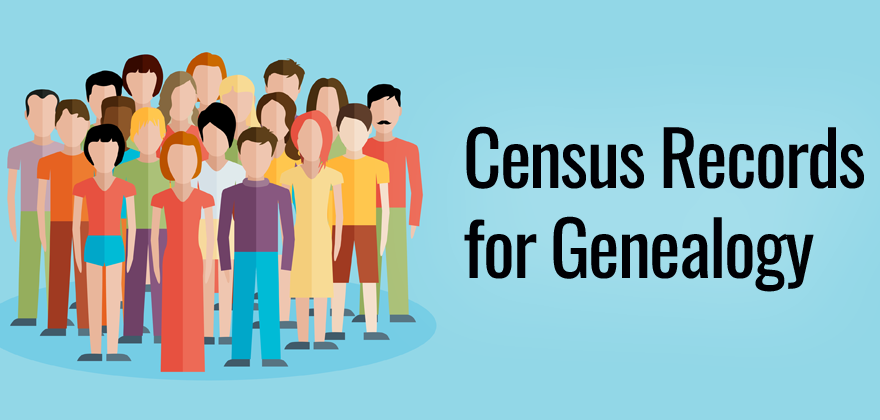Census records are some of the most valuable record types for genealogy research. They can provide a treasure trove of information, paint a picture of our ancestors’ lives, and help provide clues to discovering further records. Every family historian, whether new to genealogy or a seasoned professional, learns the importance of using census records in their research. This article will provide an overview of census records, and how to use the information they provide to your advantage.
Census records history: United States
In the United States, a census, or enumeration, of the country’s population has been taken every 10 years since 1790. Back then, census records were not thought of as a future genealogical resource! Census enumerations helped local governments track population growth and assess taxes on property, among other uses. Prior to the 1850 census, only heads of household were listed by name. Other family members were indicated by numbers or tic marks in columns denoting sex and age; for example, “Free White Persons- Males 45 and Over.” Slaves were also counted in the census through 1860, but no further details were provided other than the number of slaves owned, and their approximate ages. Starting in 1870, African American citizens were counted in the census as part of the general population.
Starting with the 1850 census, more information began to be gathered from U.S. citizens. Every family member in a household was listed by name; however, their relationship to the head of the household was not indicated until the 1880 census. Unfortunately due to a massive fire, most of the 1890 census no longer exists, leaving a 20-year gap that family historians must work around. Read our guide on 1890 census substitutes.
The National Archives observes a 72-year privacy rule regarding census records- so the 1940 census is the most recent record set available. However, the 1950 census is due to be released in April of 2022, much to the anticipation of family historians everywhere.
U.S. Census records can be easily searched on databases such as Ancestry or FamilySearch. See our guide on how to search U.S. census records.
Additionally, some U.S. states conducted their own population counts in between the national census years, and these records contain similar information to the U.S. census. Many state census records can also be found online.
Census records outside of the United States
Many other countries have conducted population counts over the decades. For example, the United Kingdom, like the U.S., also held a census every 10 years. The first UK census to request personal information from its citizens was held in 1841, making it the first census record set useful for genealogical purposes. Ireland held its first full government census in 1821, and also conducted censuses at 10-year intervals. However, much of the earlier Irish census records have been damaged or destroyed. The first complete and available census for Ireland is the 1901 census.
Use the FamilySearch Research Wiki to help determine whether your ancestor’s country of origin has any historical census records available for research.
Information found in census records
Census records can provide a wealth of valuable information about your ancestors. The Census.gov website provides many helpful resources for understanding historical U.S. census records, including the guide, “Measuring America: The Decennial Census from 1790 to 2000”.
The questions asked on the census varied from decade to decade, but the information gathered for each person can include:
- Names and ages of household members
- Value of property
- Occupation
- Place of birth
- Parents’ place of birth
- Whether someone was married, divorced, or widowed. If married, for how many years
- Number of births and living children for women
- Whether someone was a naturalized citizen and what year they naturalized
- Whether they can read, speak, or write in English
- How much schooling a person completed
- Whether someone served in the military
Census questions can also vary according to the economic status of the time. For example, the 1930 census, taken during the Great Depression, asked additional questions about employment, and whether a family owned a radio.
“Special Schedules” were also completed during certain census years and collected additional information about local populations. For example, you can find agriculture schedules for 1850 through 1870. These records collected helpful information about your farming ancestors- including the value of their land, what they grew, and the number of livestock they kept. Mortality schedules recorded deaths that occurred in the year prior to the census, an especially valuable resource for confirming an ancestor’s death. The National Archives’ “Nonpopulation Census Records” page provides further information for learning about the Special Schedules.
Using census records to your advantage
The key to getting the most out of census records is understanding how to use the information you discover to your advantage. Let’s explore what those facts can tell you about your ancestors.
Clues to how your ancestor lived
A family historian can glean a lot of information about their ancestors’ lives:
Home
How much was their property worth? Compare your ancestor’s property value to that of their neighbors. Do they stand out? Do they live in a wealthier neighborhood? Or did your ancestor rent their home, rather than own? Did they live in a large apartment building, or were they boarders?
Jobs
What did your ancestors do for a living? Did you ancestor keep the same type of job over the years? How much schooling did your ancestors complete? Did their level of education have any impact on their social status? Did the children start working at an early age, or were they able to complete high school, or even college?
Family
Who lived with your ancestor over the years? How did the family makeup change? Perhaps an elderly parent or younger sibling lived with your ancestor for a time. Remember that starting in 1880, the census provided a stated relationship to the “head of household” for each person. What circumstances would drive families to live together- perhaps an economic downturn, or the death of a family patriarch?
Opportunities to create a FAN club
FAN stands for “Friends, Associates, and Neighbors.” Learning more about the friends, associates, and neighbors of your ancestor provides helpful clues that lead to further discoveries about that ancestor. The census provides a great opportunity to build your ancestor’s FAN club.
Look at census pages before and after the one listing your ancestor, and see what information you can glean about their neighborhood: What kind of neighborhood did they live in? Did your German immigrant ancestors live in a largely German neighborhood, or were their neighbors fellow immigrants from other European countries? Does their neighborhood makeup change over the years? What is the economic status of the neighbors- do they own property, have a mortgage, or rent?
Remember to keep an eye out for any familiar names – family members often would purchase homes near each other, and you may discover a long-lost aunt lived just around the corner!
A valuable finding aid for other records
Perhaps one of the most valuable uses for the census is its role in acting as a “finding aid” for other records. A few examples include:
- Does the census indicate an ancestor served in the military? Part of the surviving 1890 census includes the Veterans Schedules, which enumerated Civil War soldiers, sailors, marines, or their widows. The inclusion of an ancestor on the veterans’ census can lead you to search for surviving pension records, service records, or other military service records for that ancestor.
- Does the census indicate that an ancestor was naturalized? Citizenship questions on the 1900 census included the year of immigration, number of years in the U.S., and whether that person was naturalized. Your ancestor’s answers can provide a starting point for locating a declaration of intent, or naturalization petition.
- Does the census indicate that a couple is married and for how many years? For example, the 1900 census asks whether a person is married, widowed, or divorced, and the number of years married. With this information, a researcher now has a timeframe to locate a possible marriage or death record.
Drawbacks to using census records
There is, unfortunately, one major drawback to relying on census records to provide information about our ancestors- we do not know WHO provided the information to the census taker. Except for the 1940 census, which indicates who the enumerator spoke to, we do not know who the “informant” was- and therefore, we cannot consider the information to be 100% reliable.
For example, if your family lived in a boarding house, the enumerator may have spoken to the building owner, a housekeeper, or another tenant. That person probably didn’t know your ancestor’s exact age, the ages of their children, or even where your ancestor was born. Information in census records must, therefore, be confirmed with other genealogical sources, to ensure that your family history research is as accurate as possible.
Another issue with census records is that your ancestor may be difficult to locate in them if you can find them at all. Family surnames were sometimes misread when indexing, especially if the enumerator’s handwriting was difficult to read. And speaking of enumerators, they sometimes had trouble spelling surnames to begin with! You may find that your ancestor’s name was spelled phonetically, or completely different than it is spelled today. If you are not finding your ancestor’s name, try spelling it different ways -or try searching for your ancestor without their surname. Instead, use identifying information such as your ancestor’s age, place of birth, and where they lived. Online databases such as Ancestry also give the option to search with “wildcards”- search tools that let you use symbols such as “?” or “*” to substitute for unknown letters, which can assist when you aren’t sure how your ancestor’s name was spelled in the census.
There is so much information waiting to be discovered in census records. What hidden treasures will you find for your family tree?



Hello,
I’m a new subscriber. In the 1880 and 1900 census….under column “place of Mother’s Birth”, my 2nd great-grandfather said “England”. He was the youngest of 10 children and not one of his siblings gave that answer. His “alleged” mother was not born in England. A puzzle/mystery I have not been able to solve. Have you ever come across this situation before.
Welcome, and thanks for subscribing! That’s such an intriguing mystery. It’s not uncommon for inconsistencies like this to pop up, as census records relied on whoever gave the information—and sometimes they guessed or got it wrong. It could point to something like an adoption, a stepmother, or even a mistake by the enumerator. I’d recommend digging into other records like birth, marriage, or death certificates to see if they offer any clues. Good luck unraveling this puzzle!
Thanks for the overview of Census in the US. Can you view the 1940 Census for free (not just a transcript)? In Australia we do not have Census records as they are destroyed. We do though have Electoral Rolls, as voting is compulsory, and you can determine a persons whereabouts from the different publications and even who lives with whom from the address as long as they are of voting age; although a few people still fall between the cracks.
Yes, I believe you can view it for free on ancestry.com and definitely on familysearch.org.